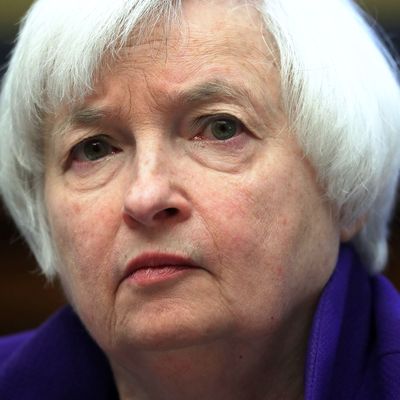
The economy is not working like the manual said it would. Despite years of near-zero interest rates, growth is slow and inflation is low. Falling home prices have reduced consumer spending by more than economists anticipated, while the declining unemployment rate has produced weaker wage gains than traditional models would have suggested. Maybe we’ve (technically) recovered from the financial crisis. But we haven’t recovered from the recovery.
The oddity of macroeconomic conditions — combined with the urgent need to restore global growth — has forced policymakers the world over to mull a range of previously taboo measures, including negative interest rates and helicopter drops.
On Friday, Federal Reserve Chair Janet Yellen made her own, tentative argument for abandoning pre-crisis orthodoxy. Speaking at the Federal Reserve Bank of Boston, Yellen suggested that the Great Recession had challenged the mainstream economic consensus in the same way that the Great Depression and the stagflation of the late 1970s had previously.
The former example led to the creation of the American welfare state, and a Keynesian consensus about the importance of propping up demand through fiscal stimulus. The latter inaugurated the reign of supply-side economics. Yellen argued that the 2008 financial crisis and its aftermath calls for a renewed focus on demand.
Before the recession, most economists believed that changes in an economy’s aggregate demand had little impact on its long-term supply. Which is to say, if consumer spending declines during a financial downturn, that won’t reduce the economy’s future capacity to produce goods and services.
The Great Recession has challenged this idea. One Federal Reserve Board study estimated that the level of potential output in the U.S. economy is now 7 percent below where it would have been, had it stayed on its pre-crisis trajectory. That is, in part, because extremely weak demand seems to have reduced the long-term supply of labor, both by discouraging immigration, and by shrinking the labor force participation rate (low wage-growth and high unemployment seem to have pushed working-age laborers onto the sidelines of the economy).
If weak demand not only causes short-term pain — but also hurts long-term economic growth — then the rationale for stimulating demand through accommodative monetary policy and expansionary fiscal policy (i.e. low interest rates, high government spending) becomes stronger than it previously was.
Yellen went on to sketch how “temporarily running a high-pressure economy” — which is to say, prioritizing high demand and a tight labor market over keeping inflation and deficits in check — might reverse the adverse effects on supply caused by the recession:
Increased business sales would almost certainly raise the productive capacity of the economy by encouraging additional capital spending, especially if accompanied by reduced uncertainty about future prospects. In addition, a tight labor market might draw in potential workers who would otherwise sit on the sidelines and encourage job-to-job transitions that could also lead to more-efficient–and, hence, more-productive–job matches. Finally, albeit more speculatively, strong demand could potentially yield significant productivity gains by, among other things, prompting higher levels of research and development spending and increasing the incentives to start new, innovative businesses.
Yellen acknowledged the risks of this “high-pressure” policy, noting that “an accommodative monetary stance, if maintained too long, could have costs that exceed the benefits by increasing the risk of financial instability or undermining price stability.”
Nonetheless, the thrust of Yellen’s remarks was that the cost of recession is likely higher than previously thought. Thus, Yellen argued that “it is even more important for policymakers to act quickly and aggressively in response to a recession” and that policymakers should consider “pursuing more stimulus in times of recovery than would be called for under the traditional view.”
This is great news for economic progressives on at least two levels. First, and most immediately, it’s a signal that the sitting Federal Reserve chair may consider tolerating inflation above 2 percent to maximize the tightness of the labor market. Modestly higher inflation is chiefly a problem for creditors (i.e. the wealthy). An unemployment rate higher than 4.5 percent — the minimum the Federal Reserve currently estimates the economy can sustain while keeping inflation below 2 percent — is chiefly a problem for poor, marginalized workers, and anyone else who could use more bargaining power in their workplaces.
The second, more abstract reason for progressives to cheer Yellen’s speech, is that it reflects a broader left-wing turn in mainstream economic thinking. If demand is the problem, liberal fiscal policy is the solution.
This change in the intellectual climate is an underappreciated reason why this year’s Democratic nominee is running on a more robustly progressive economic platform than Barack Obama did in 2008.






























